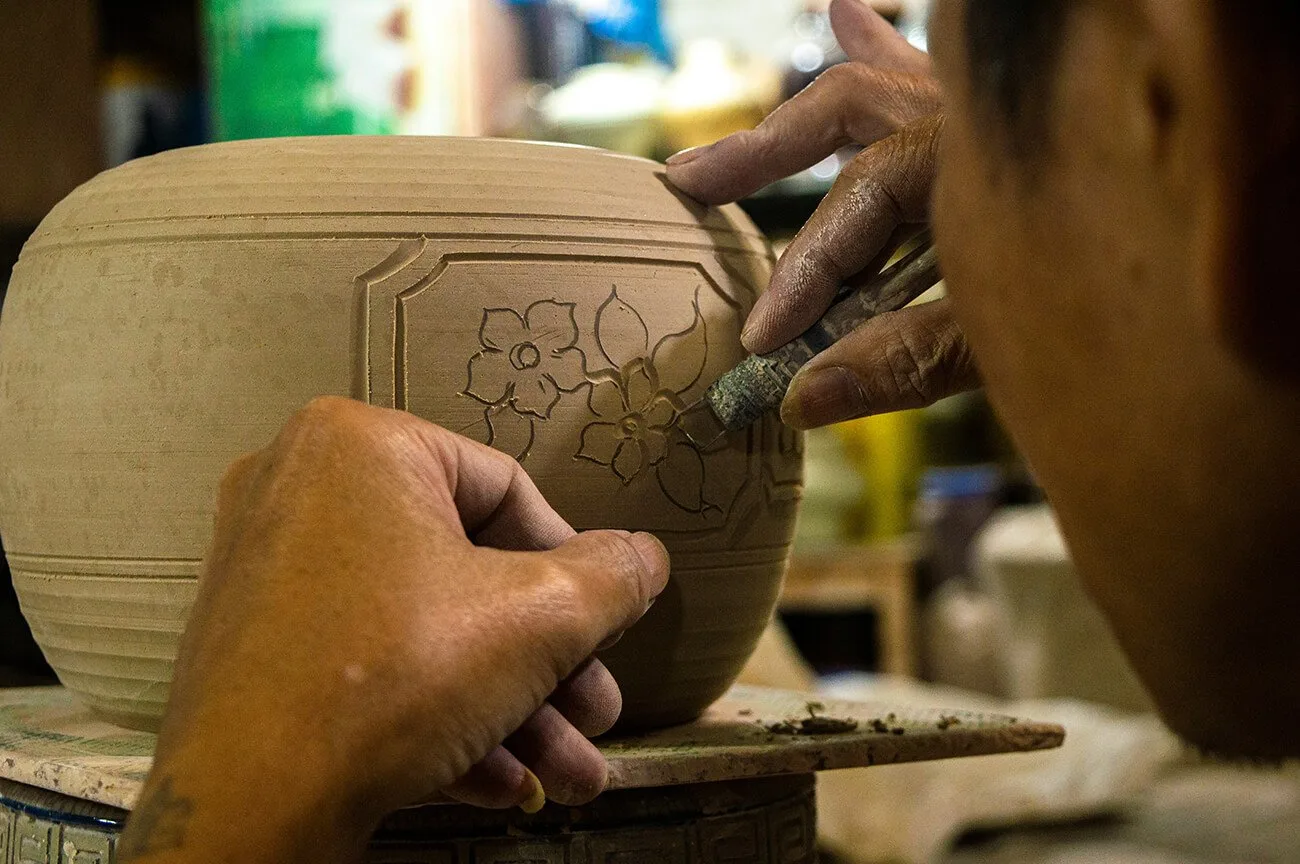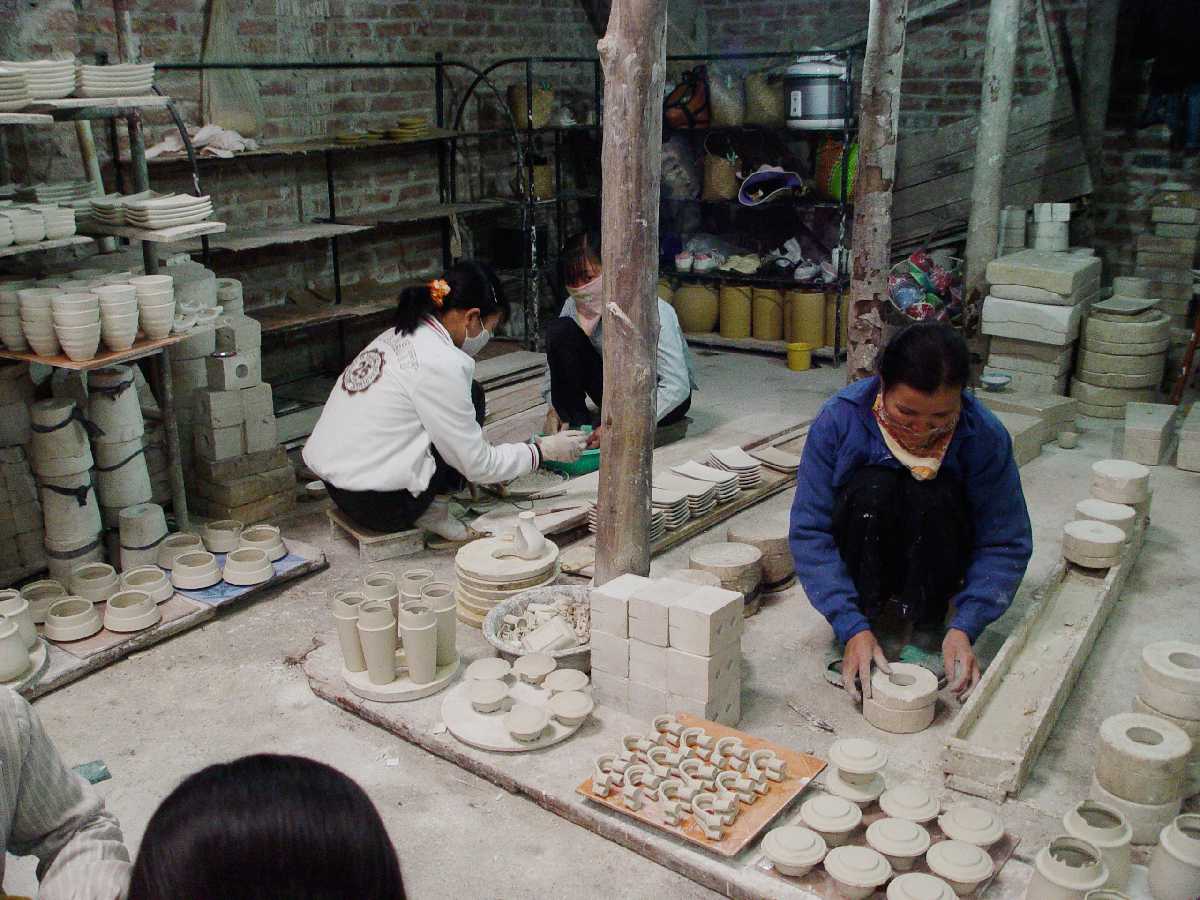News
Highlight the Social Influence of Bat Trang Ceramics Artisans
Bat Trang ceramics are not just beautiful pieces of pottery; they embody centuries of tradition, cultural identity, and social impact. This ancient craft from Bat Trang village in Vietnam has transcended its functional origins to become a significant marker of communal pride and socio-economic development. The artisans behind these ceramics play crucial roles that extend beyond their craftsmanship—they are cultural custodians, community leaders, and influencers shaping social dynamics both locally and globally.
In this article, we explore the multifaceted social influence of Bat Trang ceramics artisans through various dimensions such as their role in preserving cultural heritage, fostering community development, impacting local and global economies, promoting environmental sustainability, and inspiring artistic innovation. By delving deeper into these areas, we gain a richer understanding of how Bat Trang ceramics artisans contribute meaningfully to society far beyond their skillful hands.
Cultural Heritage Preservation Through Bat Trang Ceramics

The production of Bat Trang ceramics is deeply intertwined with Vietnamese history and cultural expressions. These artisans serve as living repositories of knowledge, techniques, and traditions that have been passed down for generations. Their craft does more than produce tangible objects—it safeguards intangible cultural heritage.
Before examining the specific impacts, it is important to recognize that the survival of any traditional art form depends heavily on active practitioners willing to uphold and adapt their skills amidst modernization pressures. Bat Trang ceramics artisans exemplify this dedication by continuously reviving old styles and integrating contemporary elements without losing authenticity.
Custodians of Traditional Craftsmanship
Bat Trang ceramics artisans inherit a legacy stretching back almost 1,000 years. Their expertise includes mastering clay selection, intricate hand-painting, glazing processes, and kiln firing techniques perfected over centuries. These skills constitute a unique cultural capital that defines the identity of the village and Vietnam’s ceramic heritage at large.
By maintaining these traditional methods, artisans resist mass-produced imitations and cultural homogenization. They offer a tactile connection to history that educates younger generations and visitors alike about Vietnamese artistic heritage. Moreover, artisans often teach apprentices within families or communities, ensuring continuity and deepening communal bonds built on shared knowledge.
This custodial role transforms artisans into cultural ambassadors who embody national pride. Their work invites appreciation and respect for Vietnamese culture worldwide, fostering intercultural dialogue and understanding.
Revitalizing Historical Narratives
Beyond technique, Bat Trang ceramics artisans embed historical narratives and symbolism into their creations. Patterns, motifs, and colors reflect ancient myths, religious beliefs, and rural life scenes, conveying stories that might otherwise fade away.
These visual histories resonate with both domestic audiences who see their ancestry reflected in everyday objects and international collectors fascinated by exotic cultural meanings. Artisans actively participate in exhibitions, festivals, and academic projects that highlight the importance of Vietnamese folklore and collective memory encoded within their ceramics.
Such efforts amplify marginalized voices and diversify dominant cultural discourses, contributing to a richer global cultural mosaic. In doing so, artisans challenge the notion that traditional crafts are merely decorative or obsolete, emphasizing their ongoing relevance as mediums for storytelling and identity affirmation.
Bridging Generational Gaps
The transmission of Bat Trang ceramics techniques creates vital intergenerational dialogues. Elder artisans pass wisdom to youth who bring fresh perspectives, blending old and new sensibilities. This exchange fosters mutual respect and strengthens family ties as well as communal cohesion.
In a rapidly urbanizing world where young people often migrate away from rural roots, Bat Trang ceramics offer a tangible reason to stay connected to ancestral lands and cultural legacies. Community workshops, school programs, and collaborative projects involving artisans attract youth engagement and inspire pride in local identity.
This bridging function underscores the social value of artisanship as more than economic activity. It becomes a platform for nurturing cultural resilience, adapting heritage to contemporary realities, and empowering future generations to carry forward their traditions with confidence.
Socioeconomic Impact of Bat Trang Ceramics Artisans

The artisans of Bat Trang ceramics significantly influence the local economy and societal welfare. Their craft supports livelihoods, stimulates tourism, and encourages entrepreneurship, thereby contributing to sustainable community development.
Understanding the breadth of this socioeconomic impact requires looking at employment patterns, income generation, market expansion, and social capital creation linked to the ceramics industry.
Driving Local Employment and Income
The Bat Trang ceramics sector provides direct employment to thousands of artisans and workers involved in various production stages—from clay extraction to final product packaging. Many families depend exclusively or partially on this trade for their financial well-being.
Artisans typically operate small-scale workshops or family-run businesses, creating decentralized economic structures that spread benefits widely within the village. This grassroots economic base helps reduce poverty levels and promotes social stability.
Additionally, the demand for high-quality handcrafted ceramics commands premium prices in local and export markets. Skilled artisans can achieve respectable incomes compared to other rural occupations, enhancing their social standing and ability to invest in education and health for their families.
Enhancing Tourism and Cultural Exchange
Bat Trang ceramics have become a major tourist attraction, drawing visitors interested in authentic cultural experiences. Tourists visit workshops, participate in pottery-making classes, and purchase souvenirs, generating significant revenue streams beyond mere manufacturing profits.
Artisans often act as informal cultural guides, sharing stories and demonstrating techniques that enrich visitors’ understanding and appreciation of Vietnamese heritage. This interaction fosters cross-cultural connections and raises awareness about the social significance of traditional crafts.
Tourism-related income also supports auxiliary services such as hospitality, transportation, and local markets, contributing to broader regional economic vitality. Thus, artisans indirectly catalyze multiple sectors through their creative products.
Promoting Entrepreneurship and Innovation
Many Bat Trang ceramics artisans exhibit entrepreneurial spirit by innovating designs, adopting modern marketing channels, and expanding distribution networks. Some establish collaborations with designers, galleries, and online platforms to reach wider audiences.
This entrepreneurial mindset empowers artisans to move beyond subsistence-level production toward sustainable business models that generate wealth and enable reinvestment in their craft and communities. Access to microfinance, training programs, and cooperative organizations further strengthen their capacity to innovate and compete in global markets.
Such initiatives reinforce artisans’ social influence by positioning them as proactive agents of change driving local economic transformation while preserving cultural authenticity.
Data Table: Socioeconomic Indicators Related to Bat Trang Ceramics Industry
| Indicator | Description | Impact Level |
|---|---|---|
| Number of Artisan Households | Approx. 2,000 households engaged in ceramics production | High |
| Average Artisan Income | 20-30% higher than regional rural average | Significant |
| Tourism Revenue Contribution | Accounts for 40% of local tourism-related earnings | Critical |
| Export Volume | Over 60% of ceramics output exported internationally | Substantial |
| Employment Multiplier Effect | Each artisan job supports 1.5 additional jobs locally | Strong |
This table illustrates how the Bat Trang ceramics industry functions as an economic engine sustaining livelihoods and enabling community prosperity through diversified channels.
Environmental Sustainability and Ethical Practices Among Artisans

The social influence of Bat Trang ceramics artisans also extends to environmental stewardship and ethical considerations. As guardians of natural resources and promoters of responsible production, they contribute positively to ecological balance and community health.
In recent years, increasing global awareness of environmental issues has pressured traditional industries to rethink resource use and waste management. Bat Trang artisans have responded with innovative approaches that integrate sustainability into their craft ethics.
Sustainable Resource Management
The primary raw materials for Bat Trang ceramics—clay, sand, and water—are extracted locally. Artisans are aware that unsustainable harvesting could lead to depletion and environmental degradation affecting their future viability.
To address this, many workshops adopt careful clay sourcing practices, such as rotating extraction sites and rehabilitating mined areas. Some collaborate with environmental experts to develop eco-friendly kilns that reduce fuel consumption and harmful emissions.
Water conservation measures include recycling rinse water and implementing rainwater harvesting systems. By minimizing ecological footprints, artisans demonstrate commitment to protecting the natural environment critical to their craft’s continuity.
Waste Reduction and Recycling Innovations
Ceramic production generates waste materials like broken pieces, defective items, and glaze residues. Traditionally discarded, these wastes now receive renewed attention for potential reuse or recycling.
Innovative artisans repurpose ceramic shards as raw material supplements, mosaic components, or construction aggregates. Others experiment with biodegradable packaging alternatives to reduce plastic waste associated with product transport.
These environmentally conscious practices align with growing consumer preferences for green products and enhance the social reputation of Bat Trang ceramics in both local and international markets. Such leadership reflects artisans’ broader responsibility towards sustainable development goals.
Ethical Labor Practices
Social influence encompasses not only environmental but also human rights dimensions. Bat Trang ceramics artisans value fair labor conditions, safe workplaces, and equitable treatment of all employees, including women and youth.
Workshops increasingly implement health and safety protocols, provide skill training, and promote gender inclusivity. Female artisans hold prominent roles in design and production, challenging traditional gender roles and empowering women economically.
By fostering ethical work environments, artisans contribute to social justice and community well-being, setting examples for other industries in Vietnam and beyond. This ethical stance enhances consumer trust and loyalty, reinforcing the artisans’ social capital.
Community Engagement and Environmental Education
Beyond internal practices, artisans engage with the wider community through environmental education initiatives. They organize awareness campaigns, school visits, and workshops highlighting the importance of sustainable living and cultural preservation.
These activities build collective consciousness around environmental challenges and encourage collaborative solutions. Artisans’ visible advocacy elevates their status as respected community leaders influencing behaviors and policies for long-term social benefit.
Artistic Innovation and Global Cultural Dialogue
Bat Trang ceramics artisans actively innovate within their craft, blending tradition with modern aesthetics to remain relevant and competitive. Their social influence manifests in shaping contemporary art trends, fostering cultural exchange, and inspiring new generations of creators worldwide.
This dynamic interplay between heritage and creativity highlights the evolving nature of artisanal influence in a globalized context.
Fusion of Traditional and Contemporary Styles
While rooted in classical forms and motifs, many Bat Trang artisans experiment with novel shapes, colors, and glazing techniques. These hybrid creations appeal to diverse audiences seeking unique yet culturally grounded artworks.
Such stylistic evolution demonstrates adaptability and openness to external influences without compromising core values. It also challenges rigid categorizations of “folk” versus “fine” art, expanding definitions of Vietnamese cultural expression.
By pushing creative boundaries, artisans stimulate artistic discourse both domestically and internationally, securing their place in contemporary art narratives.
Participation in International Exhibitions and Collaborations
Bat Trang ceramics artisans increasingly participate in global art fairs, design biennales, and cultural exchange programs. Collaborations with foreign artists and institutions facilitate cross-pollination of ideas and introduce new market opportunities.
These interactions elevate artisans from local craftsmen to global cultural actors whose works communicate universal themes such as identity, tradition, and innovation. They foster mutual respect and understanding among cultures while enhancing Vietnam’s soft power.
International recognition also motivates younger artisans to pursue excellence and experimentation, ensuring continuous renewal of Bat Trang’s artistic legacy.
Inspiring Youth and Emerging Artists
The visibility of Bat Trang ceramics at prestigious venues ignites enthusiasm among young artists and designers who draw inspiration from their techniques and narratives. Contemporary creators reinterpret Bat Trang motifs in fashion, graphic design, and digital media, extending the craft’s cultural resonance.
Artisans mentor apprentices and collaborate with academic institutions to nurture talent and preserve specialized knowledge. This mentorship cultivates a vibrant creative ecosystem that sustains Bat Trang’s relevance in changing times.
By serving as role models and cultural innovators, artisans contribute significantly to the vitality of Vietnam’s artistic landscape and its global outreach.
Expanding Market Reach Through Digital Platforms
Digital technology has transformed how Bat Trang ceramics artisans connect with customers worldwide. Online marketplaces, social media, and virtual exhibitions allow artisans to showcase their work beyond geographic limitations.
This expanded reach enhances economic opportunities and cultural exchange, making traditional ceramics accessible to new demographics. It also encourages transparency and consumer education regarding artisanal processes and values.
Embracing digital tools reflects artisans’ forward-looking mindset and willingness to engage with contemporary modalities while preserving their heritage.
Community Development and Social Cohesion Facilitated by Artisans
The social influence of Bat Trang ceramics artisans extends robustly into community development and social cohesion. Their craft serves as a fulcrum around which collective identities, social networks, and communal support systems revolve.
By fostering inclusiveness and solidarity, artisans strengthen the fabric of their village and contribute to social harmony.
Strengthening Communal Identity and Pride
The prominence of Bat Trang ceramics instills a strong sense of belonging and pride among residents. Shared participation in the craft and related festivities reinforces communal bonds.
Annual events such as pottery festivals and cultural performances celebrate collective achievements and revive traditional customs, enhancing social cohesion.
Artisans act as symbolic carriers of community identity, inspiring unity and resilience especially in times of social or economic challenges.
Encouraging Cooperative Structures and Mutual Support
Many Bat Trang artisans organize themselves into cooperatives or associations to pool resources, share knowledge, and advocate for common interests. These collective entities enhance bargaining power in markets and policymaking arenas.
Cooperatives foster mutual aid mechanisms such as microcredit, joint marketing campaigns, and group training sessions, improving artisans’ livelihoods and social security.
This cooperative spirit exemplifies solidarity-driven development models that build inclusive and participatory communities anchored in shared cultural heritage.
Promoting Gender Equality and Social Inclusion
The ceramics industry in Bat Trang actively promotes gender equality by supporting female artisans’ leadership roles and economic participation.
Women contribute significantly to production, design, and business operations, challenging traditional gender norms and advancing women’s empowerment.
Furthermore, artisans often engage disadvantaged groups, including ethnic minorities and disabled persons, creating pathways for social inclusion and equity.
Such inclusive practices highlight the transformative potential of artisan communities in addressing broader social justice issues.
Facilitating Social Capital and Networking
Through daily interactions, collaborations, and cultural exchanges, Bat Trang ceramics artisans cultivate extensive social networks spanning local, national, and international spheres.
This social capital facilitates access to information, funding, and markets, enhancing community resilience and adaptive capacity.
Artisans leverage these networks to influence public policies, secure cultural heritage protection, and promote sustainable development agendas benefiting the wider society.
Conclusion
The social influence of Bat Trang ceramics artisans extends far beyond their exquisite craftsmanship, permeating cultural, economic, environmental, artistic, and communal domains. As custodians of an ancient heritage, economic drivers, environmental stewards, creative innovators, and community builders, these artisans play indispensable roles in shaping social realities locally and globally. Their dedication preserves identity and tradition, nurtures livelihoods, fosters cultural dialogue, and strengthens social cohesion. Recognizing and supporting the multifaceted contributions of Bat Trang ceramics artisans is essential not only for safeguarding a treasured craft but also for promoting sustainable, inclusive, and culturally rich societies well into the future.
